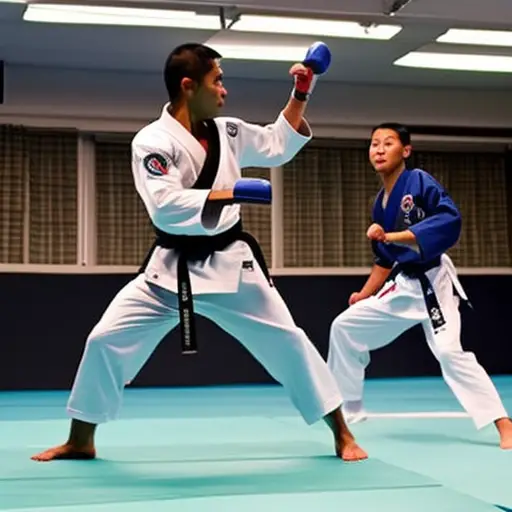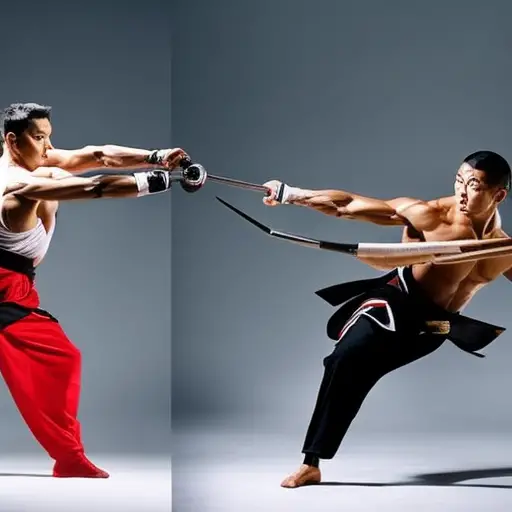Flexibility Training for Taekwondo

Imagine yourself effortlessly executing high kicks and fluid movements in your Taekwondo practice. Achieving such agility and grace is not only a result of physical strength, but also the benefits of flexibility training.
In this article, we will explore the role of flexibility in Taekwondo performance and provide practical techniques to improve your range of motion. Discover dynamic stretching exercises, static stretching techniques, and other approaches that will enhance your flexibility and take your Taekwondo skills to new heights.
The Benefits of Flexibility Training in Taekwondo
One of the key advantages of incorporating flexibility training into a taekwondo regimen is the improvement of performance and injury prevention. Flexibility plays a crucial role in taekwondo, as it allows practitioners to perform high kicks, dynamic movements, and quick transitions with ease. By increasing flexibility, athletes can achieve a greater range of motion in their joints, which enables them to execute techniques more effectively and efficiently.
The benefits of flexibility training in taekwondo extend beyond performance enhancement. Regular stretching exercises help to maintain and improve joint health, reducing the risk of injuries during training and competitions. Flexibility training also aids in muscle recovery and alleviates muscle soreness, allowing athletes to bounce back quickly from intense training sessions.
In addition, flexibility training promotes overall body balance and coordination, which are essential for executing complex techniques in taekwondo. It improves body awareness and control, enabling practitioners to maintain proper form and technique during movements. This not only enhances the aesthetic aspect of taekwondo but also ensures optimal power and accuracy in strikes and kicks.
Understanding the Role of Flexibility in Taekwondo Performance
Flexibility plays a crucial role in enhancing the performance of taekwondo practitioners and should be thoroughly understood. It not only allows for a wider range of motion but also plays a significant role in injury prevention. In taekwondo, different techniques require different levels of flexibility, and understanding the role of flexibility in each technique is essential for optimal performance.
Firstly, flexibility is vital in preventing injuries in taekwondo. By improving flexibility, practitioners can increase their joint mobility and reduce the risk of muscle strains and tears. This is particularly important in high-impact movements such as kicks and jumps, where limited flexibility can lead to injuries.
Secondly, different taekwondo techniques require varying degrees of flexibility. For example, high kicks require exceptional hip and hamstring flexibility, while spinning kicks rely on flexibility in the hips, spine, and shoulders. By incorporating specific flexibility exercises into their training, taekwondo practitioners can improve their performance in these techniques and execute them with more precision and power.
To enhance flexibility for different taekwondo techniques, practitioners can incorporate dynamic stretching, static stretching, and proprioceptive neuromuscular facilitation (PNF) stretching into their training routines. These techniques target specific muscle groups and joint movements, helping to improve flexibility in the areas needed for specific techniques.
Key Principles for Effective Flexibility Training
To ensure effective flexibility training for Taekwondo, it is essential to incorporate proper warm-up techniques and stretching exercises.
A thorough warm-up prepares the body for the demands of training, increasing blood flow and flexibility.
Stretching exercises, such as dynamic stretches and static holds, help to improve range of motion and prevent injuries.
Proper Warm-Up Techniques
Three essential principles for effective flexibility training warm-up techniques in Taekwondo should be followed to ensure optimal performance and reduce the risk of injury. First, it is important to incorporate dynamic warm-up exercises that mimic the movements and intensity of the upcoming training session. This helps to increase blood flow, elevate body temperature, and prepare the muscles for action. Second, the warm-up should focus on joint mobility exercises to improve range of motion and flexibility. This can include exercises such as leg swings, arm circles, and spinal twists. Lastly, it is crucial to gradually increase the intensity and duration of the warm-up to avoid sudden stress on the body. By following these principles, Taekwondo practitioners can enhance their performance and minimize the likelihood of injuries.
| Principles for Effective Warm-Up Techniques | ||
|---|---|---|
| Incorporate dynamic warm-up exercises | Focus on joint mobility exercises | Gradually increase intensity and duration |
| Increase blood flow and elevate body temperature | Improve range of motion and flexibility | Minimize the likelihood of injuries |
Stretching Exercises for Flexibility
To optimize flexibility training in Taekwondo, practitioners should incorporate stretching exercises that focus on key principles for effective training. Stretching techniques play a crucial role in improving flexibility and preventing injuries.
One of the most common methods is static stretching, which involves holding a position for a prolonged period. This helps lengthen and relax the muscles, allowing for increased range of motion.
Another technique is dynamic stretching, which involves moving through a full range of motion while gradually increasing speed and intensity. This method helps improve flexibility while also warming up the body for more intense activity.
Additionally, proprioceptive neuromuscular facilitation (PNF) stretching is highly effective for increasing flexibility. This method involves contracting and relaxing muscles while simultaneously stretching them.
Dynamic Stretching Exercises for Improved Flexibility
Numerous dynamic stretching exercises can be incorporated into a taekwondo training regimen to enhance overall flexibility and improve performance. Dynamic stretching involves moving through a full range of motion in a controlled manner, which helps to warm up the muscles and increase blood flow. One effective dynamic stretching exercise for taekwondo is the use of resistance bands. These bands provide resistance throughout the movement, which helps to further stretch and strengthen the muscles.
Resistance band exercises can target specific muscle groups that are important for taekwondo, such as the hamstrings, hip flexors, and shoulders. For example, a dynamic stretching exercise using a resistance band can involve standing with one foot inside the band and then lifting the leg forward and backward while maintaining tension on the band. This exercise not only stretches the hamstrings but also activates the hip flexors, which are crucial for high kicks in taekwondo.
In addition to improving flexibility, dynamic stretching exercises also play a role in injury prevention. By gradually increasing the intensity and range of motion during these exercises, the muscles and connective tissues become more adaptable and resilient to the demands of taekwondo training and competition. This flexibility training helps to reduce the risk of muscle strains and joint injuries that can occur during dynamic movements.
Static Stretching Techniques to Enhance Taekwondo Flexibility
While dynamic stretching exercises are effective for improving flexibility in taekwondo, static stretching techniques can also be incorporated to further enhance flexibility and optimize performance. Static stretching involves holding a stretch for an extended period, usually between 15 to 60 seconds, without any movement. This type of stretching is beneficial for taekwondo practitioners as it helps to lengthen and relax the muscles, increase joint range of motion, and improve overall flexibility.
Here are three key benefits of incorporating static stretching techniques in taekwondo flexibility training:
-
Increased muscle elasticity: Static stretching allows the muscles to elongate and adapt to a greater range of motion, improving overall flexibility and reducing the risk of injury during taekwondo movements.
-
Improved muscle relaxation: Holding a static stretch helps to relax the muscles, reducing muscle tension and promoting better muscle recovery after intense training sessions.
-
Enhanced joint mobility: Static stretching can increase joint range of motion, enabling taekwondo practitioners to perform kicks and other techniques with greater ease and effectiveness.
By combining static stretching techniques with dynamic stretching exercises, taekwondo practitioners can experience a comprehensive approach to flexibility training, optimizing their performance and reducing the risk of injuries associated with inadequate flexibility.
Now, let’s explore the next section on utilizing proprioceptive neuromuscular facilitation (PNF) in flexibility training.
Utilizing Proprioceptive Neuromuscular Facilitation (PNF) in Flexibility Training
Proprioceptive Neuromuscular Facilitation (PNF) techniques have been proven to be highly effective in improving flexibility in athletes, including Taekwondo practitioners.
By incorporating PNF into their training routines, Taekwondo athletes can experience significant gains in range of motion and muscular flexibility.
PNF techniques involve a combination of stretching and contracting muscles, which helps to override the body’s natural protective mechanisms and allow for increased flexibility.
PNF Techniques Effectiveness
Utilizing Proprioceptive Neuromuscular Facilitation (PNF) techniques in flexibility training has been shown to significantly improve range of motion and enhance performance in Taekwondo practitioners. PNF techniques involve combining passive stretching with isometric contractions and subsequent relaxation to achieve greater flexibility gains.
Here are some benefits and variations of PNF techniques:
-
Benefits of PNF techniques:
-
Increased flexibility: PNF techniques target both the muscle and the nervous system, allowing for greater gains in range of motion.
-
Improved muscle coordination: PNF techniques help improve the communication between muscles and the brain, enhancing overall movement efficiency.
-
Injury prevention: By increasing flexibility and muscle coordination, PNF techniques can help reduce the risk of injuries during training or competition.
-
Variations of PNF techniques:
-
Hold-relax: In this technique, the muscle is stretched passively, followed by an isometric contraction, and then a period of relaxation.
-
Contract-relax: Similar to hold-relax, but instead of relaxation, a concentric muscle contraction is performed after the isometric contraction.
-
Slow-reversal-hold-relax: This variation involves alternating between an agonist and antagonist muscle contraction to achieve a deeper stretch.
Incorporating PNF techniques into flexibility training can provide Taekwondo practitioners with significant improvements in their range of motion and overall performance.
Incorporating PNF Into Routines
One effective way to incorporate PNF techniques into flexibility training routines is by including a series of dynamic stretching exercises that engage the targeted muscles in controlled contractions and relaxations.
PNF, or Proprioceptive Neuromuscular Facilitation, is a stretching method that involves alternating between contracting and relaxing the muscles being stretched. This technique helps to improve flexibility by utilizing the body’s natural reflexes to achieve a deeper stretch.
During a PNF stretching session, the muscle is first stretched to its limit, and then a contraction is performed against resistance for a few seconds. This is followed by a relaxation phase where the muscle is allowed to relax and lengthen further.
By incorporating PNF techniques into flexibility training, Taekwondo practitioners can enhance their range of motion and improve their performance in various techniques.
Transition:
Another effective way to enhance flexibility for Taekwondo is by incorporating yoga and pilates into the training routine.
Incorporating Yoga and Pilates for Enhanced Taekwondo Flexibility
To optimize flexibility in Taekwondo practitioners, incorporating a regular yoga and Pilates routine can significantly enhance their range of motion and overall performance. Both yoga and Pilates are popular forms of exercise that focus on strength, flexibility, and body awareness. When combined with Taekwondo training, these practices can provide numerous benefits for martial artists looking to improve their flexibility.
Here are some key benefits of incorporating yoga and Pilates for enhanced Taekwondo flexibility:
-
Increased Range of Motion: Yoga and Pilates movements target different muscle groups, helping to improve overall flexibility and joint mobility. This increased range of motion can benefit Taekwondo practitioners, as it allows for more fluid and powerful kicks, punches, and movements.
-
Improved Core Strength: Both yoga and Pilates emphasize core strength and stability. A strong core is essential for maintaining balance and generating power in Taekwondo techniques.
-
Enhanced Body Awareness: Yoga and Pilates require practitioners to focus on proper alignment and body awareness. This heightened sense of body awareness can translate into improved technique and form in Taekwondo.
Progression and Maintenance Strategies for Long-Term Flexibility Improvement
Consistently implementing appropriate progression and maintenance strategies is crucial for achieving long-term flexibility improvement in Taekwondo practitioners.
Progression strategies involve gradually increasing the intensity and duration of flexibility exercises over time. This allows the body to adapt and become more flexible without risking injury. Taekwondo athletes can use various methods to progress their flexibility, such as increasing the range of motion in their stretches, using resistance bands or weights to add resistance, or incorporating dynamic stretching into their routines.
Maintenance strategies are equally important in sustaining flexibility gains. Once a desired level of flexibility is achieved, it is essential to continue practicing flexibility exercises regularly to prevent loss of flexibility. Regular stretching sessions, at least two to three times a week, should be incorporated into the training routine. It is also advisable to include a variety of stretching techniques to target different muscle groups and maintain overall flexibility.
In addition to regular stretching, other maintenance strategies can include foam rolling, massage therapy, and active recovery exercises. Foam rolling helps release muscle tension and improve muscle flexibility. Massage therapy can relieve muscle tightness and promote blood circulation. Active recovery exercises, such as light jogging or swimming, can help maintain flexibility by keeping the muscles active and preventing them from becoming stiff.
Frequently Asked Questions
Are There Any Risks or Potential Injuries Associated With Flexibility Training in Taekwondo?
Flexibility training, like any form of physical activity, carries inherent risks. Injuries such as muscle strains, sprains, and joint hyperextension can occur if proper technique, warm-up, and progression are not followed.
How Often Should I Engage in Flexibility Training to See Significant Improvements in My Taekwondo Performance?
To see significant improvements in taekwondo performance, it is essential to engage in flexibility training with the appropriate frequency. However, it is equally important to incorporate rest days to allow the body to recover and prevent overuse injuries.
Can Flexibility Training Alone Improve My Taekwondo Kicks and Overall Technique?
Flexibility training plays a crucial role in improving kicks and overall technique in Taekwondo. By enhancing joint mobility and range of motion, it allows practitioners to achieve higher kicks and execute techniques with greater precision and power.
Are There Any Specific Warm-Up Exercises That Should Be Done Before Starting Flexibility Training for Taekwondo?
Specific warm-up exercises are crucial before starting flexibility training for Taekwondo. They prepare the body for intense stretching, reduce the risk of injury, and enhance performance. Incorporating dynamic movements and targeted stretches can maximize the benefits of flexibility training.
Are There Any Specific Dietary or Nutritional Recommendations to Support Flexibility Training in Taekwondo?
Dietary recommendations and nutritional requirements play a crucial role in supporting flexibility training, particularly in taekwondo. Adequate intake of essential nutrients, such as protein, vitamins, and minerals, can enhance muscle elasticity and promote overall physical performance.
Conclusion
In conclusion, incorporating flexibility training into taekwondo practice is crucial for improving performance and preventing injuries.
By understanding the role of flexibility and implementing key principles, such as dynamic and static stretching, proprioceptive neuromuscular facilitation, and incorporating yoga and Pilates, practitioners can enhance their flexibility and overall skill level.
It is important to follow progression and maintenance strategies for long-term improvement.
Remember, flexibility is not just about physicality, but also about mental and emotional adaptability, allowing practitioners to reach their full potential and excel in taekwondo.




